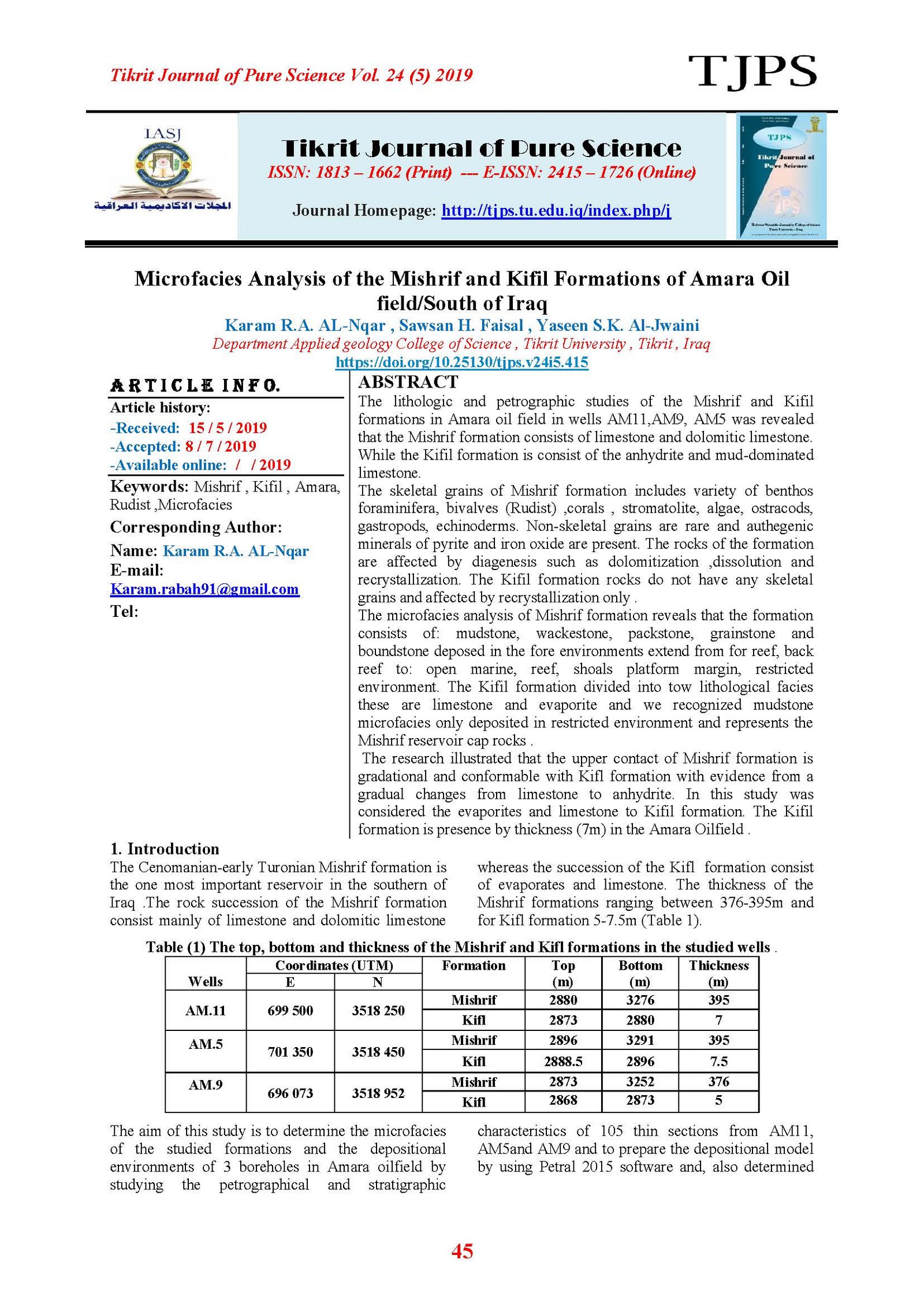Microfacies Analysis of the Mishrif and Kifil Formations of Amara Oil field/South of Iraq
Main Article Content
Abstract
The lithologic and petrographic studies of the Mishrif and Kifil formations in Amara oil field in wells AM11,AM9, AM5 was revealed that the Mishrif formation consists of limestone and dolomitic limestone. While the Kifil formation is consist of the anhydrite and mud-dominated limestone.
The skeletal grains of Mishrif formation includes variety of benthos foraminifera, bivalves (Rudist) ,corals , stromatolite, algae, ostracods, gastropods, echinoderms. Non-skeletal grains are rare and authegenic minerals of pyrite and iron oxide are present. The rocks of the formation are affected by diagenesis such as dolomitization ,dissolution and recrystallization. The Kifil formation rocks do not have any skeletal grains and affected by recrystallization only .
The microfacies analysis of Mishrif formation reveals that the formation consists of: mudstone, wackestone, packstone, grainstone and boundstone deposed in the fore environments extend from for reef, back reef to: open marine, reef, shoals platform margin, restricted environment. The Kifil formation divided into tow lithological facies these are limestone and evaporite and we recognized mudstone microfacies only deposited in restricted environment and represents the Mishrif reservoir cap rocks .
The research illustrated that the upper contact of Mishrif formation is gradational and conformable with Kifl formation with evidence from a gradual changes from limestone to anhydrite. In this study was considered the evaporites and limestone to Kifil formation. The Kifil formation is presence by thickness (7m) in the Amara Oilfield .
Article Details

This work is licensed under a Creative Commons Attribution 4.0 International License.
Tikrit Journal of Pure Science is licensed under the Creative Commons Attribution 4.0 International License, which allows users to copy, create extracts, abstracts, and new works from the article, alter and revise the article, and make commercial use of the article (including reuse and/or resale of the article by commercial entities), provided the user gives appropriate credit (with a link to the formal publication through the relevant DOI), provides a link to the license, indicates if changes were made, and the licensor is not represented as endorsing the use made of the work. The authors hold the copyright for their published work on the Tikrit J. Pure Sci. website, while Tikrit J. Pure Sci. is responsible for appreciate citation of their work, which is released under CC-BY-4.0, enabling the unrestricted use, distribution, and reproduction of an article in any medium, provided that the original work is properly cited.
References
[1] Dunington, H.o., Wetzel R. and Morton D.M 1959, Mesozoic and Paleozoic :in van Bellen, R.C , Dunnington H.V., Wetzel , R and Morton D.M.1959; Lexique stratigraphy international.
[2] Aqrawi, A.A.M. Thehni G,A, Sherwani, G.H. and Kareem,B.M.A,.1998 Mid-Cretaceous rudist bearing carbonates of the Mishrif formation :an important reservoir sequence in the Mesopotamian Basin ,Jornal of petroleum Geology ,21,57-82.
[3] Chatton,m. and Hart, E,1961. Review of the Cenomanian to Maastrichtian stratigraphy in Iraq Manuscript report NO.2/141, INOC Library, Baghdad.
[4]Sadooni; F.N; 2005 possible hydrocarbon stratigraphy entrapment in the upper Cretaceous basin-margin rudist buildups of the Mesopotamian Basin, southern Iraq. Cretaceous Research Z6.213-244.
[5] Al-Badry, A.M., 2005. Sequence Stratigraphy of the Mishrif Formation in Selected Oil Fields Within Miesan County, South Iraq. Unpub. M.Sc. Thesis, University of Baghdad, 83pp (in Arabic).
[6] AL-Bahadily J.K.R .2018 Integrated Reservoir Characterization Improvement in Heterogeneity Modeling for Mishrif Formation of Amara Oil field in south Iraq. Master Thesis, collage of science, University of Baghdad, 184p.
[7] Aqrawi, A.A.M. and Evans, G, 1994, Brackish-water and evaporitic Ca-Mg carbonate in the Holocene lacustrinel/deltaic deposits of southern mesopotamai, Journal of the Geological Society London,125:p. 259-268 .
[8] Jassim, S.Z. & Goff, J.C., 2006: Geology of Iraq. Published by Dolin, Prague and Moravian Mus. Brno, 341p.
[9] Dunham, R. J.(1962): Classification of Carbonate rocks Accordiny to Depositional Texture, in: Ham, W.E. (ed), Classification of Carbonate Rocks, A.A.P.G Me.-1, Tulsa, Okla., pp.108-12
[10] Wilson, J. L. (1975): Carbonate Facies in Geologic History, Springer Verlag, Berlin, 475 p
[11] MOC. Final Geological Report AM11
[12]Emin ALICI et.al 2008. Eighth International Congress on Rudist Cretaceous and Carbonate Platforms. EIGHTH INTERNATIONAL CONGRESS ON RUDISTS June 23-25, 2008-zmir, Turkey.
[13] Scholle P. A., 2003. A Color Guide to the Petrography of Carbonate Rocks: Grains, textures, porosity, diagenesis. AAPG Memoir 77, Published byThe American Association of Petroleum Geologists Tulsa, Oklahoma, U.S.A., 459p.
[14] AL-Naqib,K.M,.1967.Geology of the Arabian Peninsula, South Western Iraq. United States Geological survey, Professional Paper,560 G,54 .
[15] Aqrawi, A.A.M. Thehni G,A, Sherwani, G.H. and Kareem, B.M.A,. 1998 Mid-Cretaceous rudist bearing carbonates of the Mishrif formation :an important reservoir sequence in the Mesopotamian Basin ,Jornal of petroleum Geology ,21,57-82.
[16] Aqrawi, A. A. M., Horbury, A.D., Goof, J. C. and Sadooni, F.N., 2010. The Petroleum Geology Of Iraq. Seientific Press Ltd, Great Britain,pp424.
[17] Alkersan, H., 1975, Depositional environment and geological history of the Mishrif formation in southern Iraq .9th Arab prtroleum Congress, Dubai UAE, paper121(section B-3). 1-18 .
[18] Gaddo, J.H 1971. The Mishrif formation palaeoenviroment in the Rumaila/Tuba/Zubair region of S. Iraq . Journ. Geol. Soc Iraq,4,1-2 .
[19] Cannon, S. 2018, Reservoir Modelling: A Practical Guide, First Edition. Steve Cannon.© 2018 John Wiley & Sons Ltd. Published 2018 by John Wiley & Sons Ltd.
[20] Schlumberger, 2015. Petrel property modeling course, 544p.
